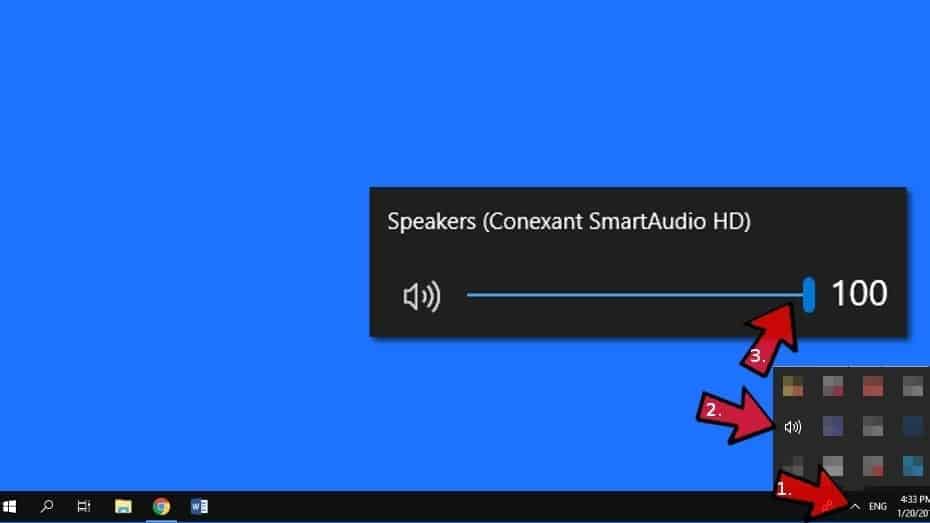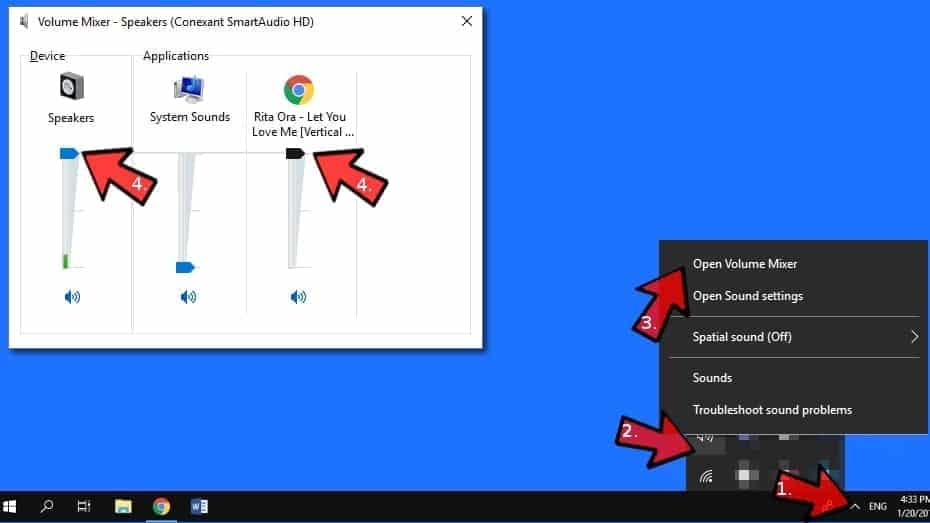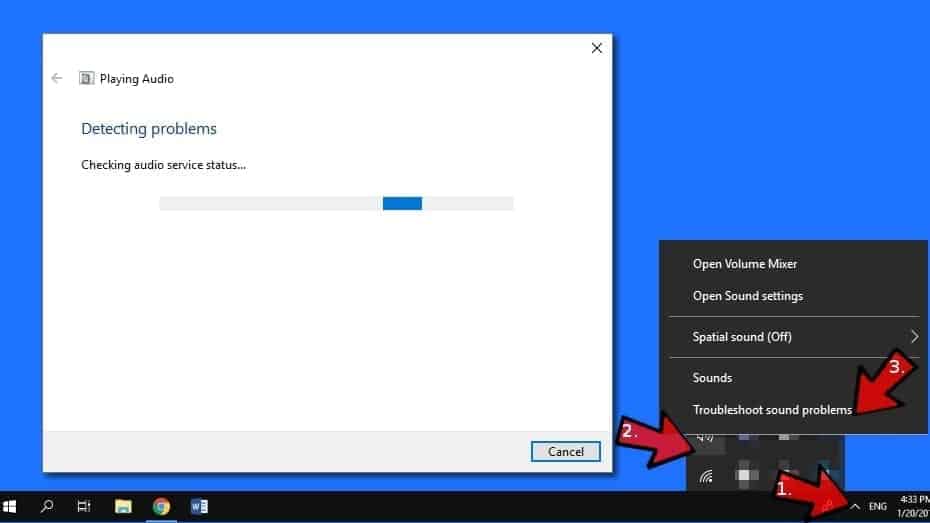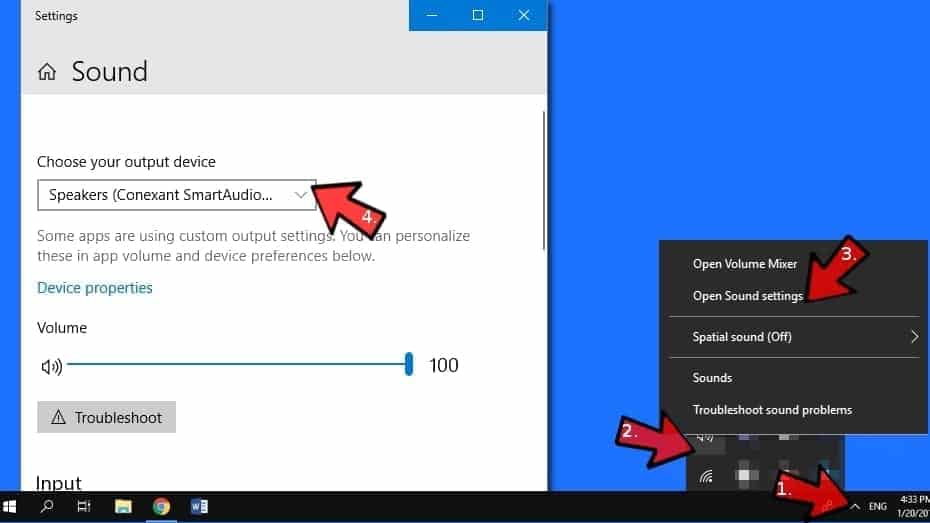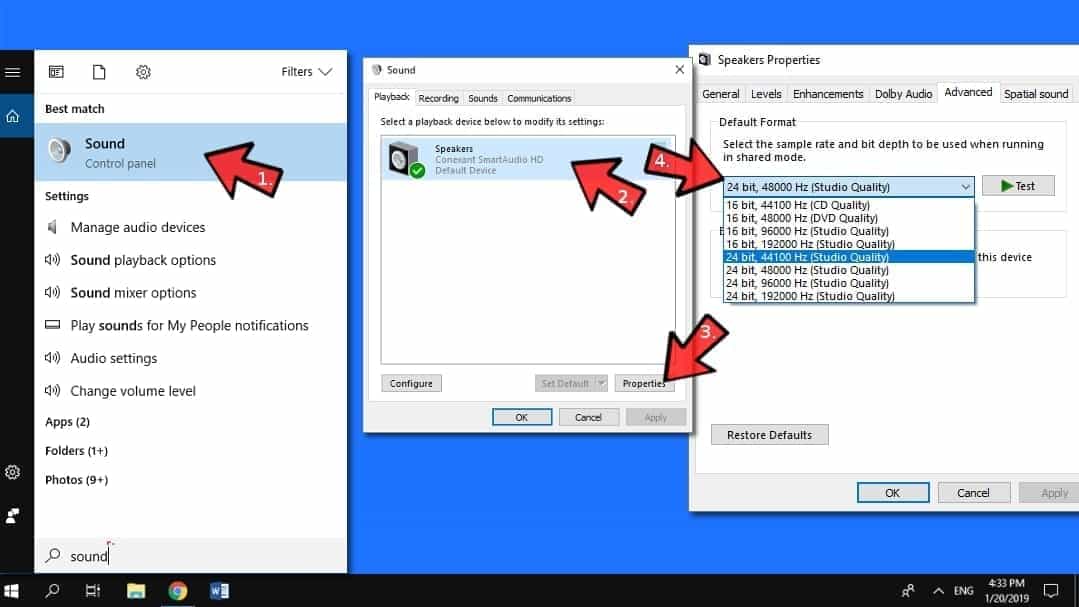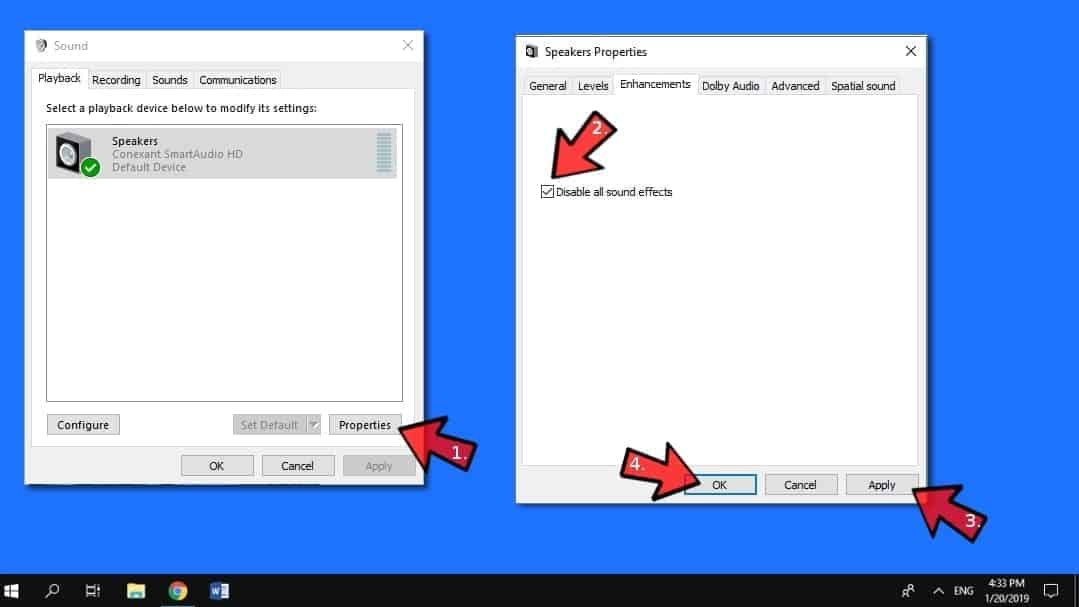- Fix sound problems in Windows 10
- How to Fix Sound Problems in Windows 10
- No sound in Windows 10 is a typical error
- 8 ways to fix audio issues in Windows 10
- Method 1. Check hardware problems
- Method 2. Check audio hardware cables
- Method 3. Turn volume up
- Method 4. Fix no sound the easy way – run Audio Troubleshooter
- Method 5. Configure Sound Settings
- Step 1. Select the output device
- Step 2. Choose the default playback device
- Step 3. Change audio format
- Method 6. Fix audio drivers
- Method 7. Disable audio enhancements
- Method 8. Restart Windows audio service
Fix sound problems in Windows 10
If you’re having audio problems, the following suggestions might help. The tips are listed in order, so start with the first one, see if that helps, and then continue to the next one if it doesn’t.
If multiple audio output devices are available, check that you have the appropriate one selected. Here’s how:
Select the Speakers icon on the taskbar.
Next, select the arrow to open a list of audio devices connected to your computer.
Check that your audio is playing to the audio device you prefer, such as a speaker or headphones.
If this doesn’t help, continue to the next tip.
The audio troubleshooter might be able to fix audio problems automatically.
To run the troubleshooter
In the search box on the taskbar, type audio troubleshooter, select Fix and find problems with playing sound from the results, then select Next.
Select the device you want to troubleshoot and then continue through the troubleshooter.
You can also launch the troubleshooter from audio Settings. Select Start > Settings > System > Sound > Troubleshoot.
If running the troubleshooter doesn’t help, continue to the next tip.
To check for updates
Select Start > Settings > Update & Security > Windows Update > Check for updates.
Do one of the following:
If the status says «You’re up to date, go to the next tip.
If the status says «Updates are available,» select Install now.
Select the updates you want to install, then select Install.
Restart your PC and see if your sound is working properly.
If that didn’t solve your problem, continue to the next tip.
Try these steps
Check your speaker and headphone connections for loose cords or cables. Make sure all cords and cables are plugged in.
If you have multiple 5mm jacks to plug into, especially on a surround sound system, make sure all cords and cables are plugged into the correct jack.
If it’s not clear which jack goes with which cord, consult your hardware manufacturer, or try the most obvious outputs one at a time and see if they work.
Note: Some systems use a green jack for output and pink for mic input and others will be labeled «headphone» or «microphone.»
Make sure the power is turned on and check the volume level.
Make sure the mute setting is not turned on, and try turning up all the volume controls.
Remember some speakers and apps have their own volume controls. Be sure to check them all.
Try connecting your speaker and headphones to a different USB port.
It’s possible that your speakers won’t work when your headphones are plugged in. Unplug your headphones and see if that helps.
If your cables and volume are OK, see the next sections for additional troubleshooting.
Check to make sure your audio devices aren’t muted and haven’t been disabled.
Right-click the Speakers icon on the taskbar, and then select Open Volume mixer.
You’ll see a set of volume controls for your devices. Make sure none of them are muted. If any of them are muted, you’ll see a red circle with a line through it next to the volume control. In that case, select the volume control to unmute.
Check your device properties to make sure that your devices have not been disabled by mistake. Select Start > Settings > System > Sound .
Select your audio device, and then select Device properties. Be sure to select Device properties for both the output and input devices.
Make sure the Disable check box is cleared for the output and input devices.
If that didn’t solve your problem, continue to the next tip.
Hardware problems can be caused by outdated or malfunctioning drivers. Make sure your audio driver is up to date and update it if needed. If that doesn’t work, try uninstalling the audio driver (it will reinstall automatically). If that doesn’t work, try using the generic audio driver that comes with Windows. If you’re having audio issues after installing updates, try rolling back your audio driver.
To update your audio driver automatically
In the search box on the taskbar, type device manager, then select it from the results.
Select the arrow next to Sound, video and game controllers to expand it.
Right-click the listing for your sound card or audio device, such as headphones or speakers, select Update driver, then select Search automatically for updated driver software. Follow the instructions to complete the update.
If Windows doesn’t find a new driver, look for one on the device manufacturer’s website and follow those instructions. If that doesn’t work, try uninstalling your audio driver.
To uninstall your audio driver
In the search box on the taskbar, type device manager, then select it from the results.
Select the arrow next to Sound, video and game controllers to expand it.
Right-click the listing for your sound card or audio device, select Uninstall device, select the Delete the driver software for this device check box, and then select Uninstall.
Restart your PC.
Note: Be sure to save documents and any other current work before you restart.
This restart will automatically prompt your PC to reinstall your audio driver.
To restart, select Start > Power > Restart .
If those options didn’t work, try using the generic audio driver that comes with Windows.
To use the generic audio driver that comes with Windows
In the search box on the taskbar, type device manager, then select it from the results.
Select the arrow next to Sound, video and game controllers to expand it.
Right-click the listing for your sound card or audio device, then select Update driver > Browse my computer for driver software > Let me pick from a list of device drivers on my computer.
Select the audio device whose driver you want to update, select Next, and then follow the instructions to install it.
If these steps didn’t solve your audio issue, visit your device manufacturer’s website and install the most recent audio/sound drivers for your device. Following is an example of a driver download page for a sound device manufacturer.
If you have audio issues after installing updates
If your audio was working before you ran Windows Update and now isn’t working, try rolling back your audio driver.
To roll back your audio driver
In the search box on the taskbar, type device manager, then select it from the results.
Select the arrow next to Sound, video and game controllers to expand it.
Right-click the listing for your sound card or audio device, then select Properties.
Select the Driver tab, then select Roll Back Driver.
Read and follow the instructions and then select Yes if you want to roll back your audio driver.
If rolling back your audio driver didn’t work or wasn’t an option, you can try to restore your PC from a system restore point.
Restore your PC from a system restore point
When Microsoft installs updates on your system, we create a system restore point in case problems arise. Try restoring from that point and see if that fixes your sound problems. For more info, see «Restore from a system restore point» in Recovery options in Windows 10.
If you’re connecting to an audio device—such as headphones or speakers—using USB or HDMI, you might need to set that device as the default audio device. If you’re using an external monitor that doesn’t have built-in speakers, make sure that the monitor isn’t already selected as your default output device. if it is, you won’t have any audio. You can check that when you set your default output audio device. Here’s how:
In the search box on the taskbar, type control panel, then select it from the results.
Select Hardware and Sound from the Control Panel, and then select Sound.
On the Playback tab, right-click the listing for your audio device, select Set as Default Device, and then select OK.
If setting your audio device as the default device doesn’t help, continue to the next tip for additional troubleshooting.
Sometimes having audio enhancements on can result in audio issues. Disabling them may resolve your issue.
In the search box on the taskbar, type control panel, then select it from the results.
Select Hardware and Sound from the Control Panel, and then select Sound.
On the Playback tab, right-click the Default Device, and then select Properties.
On the Enhancements tab, select either the Disable all enhancements or the Disable all sound effects check box (depending on which option you see), select OK, and try to play your audio device.
If that doesn’t work, on the Playback tab, select another default device (if you have one), select either the Disable all enhancements or the Disable all sound effects check box (depending on which option you see), select OK, and try to play audio again. Do this for each default device.
If turning off audio enhancements doesn’t help, see the next sections for additional troubleshooting.
In the search box on the taskbar, type services, then select it from the results.
Select each of the following services, right-click, and then select Restart:
Windows Audio Endpoint Builder
Remote Procedure Call (RPC)
If restarting these services doesn’t resolve your issue, see the next sections for more troubleshooting.
In the search box on the taskbar, type control panel, and then select it from the results.
Select Hardware and Sound from the Control Panel, and then select Sound.
On the Playback tab, right-click (or press and hold) Default Device, and then select Properties.
On the Advanced tab, under Default Format, change the setting, select OK,and then test your audio device. If that doesn’t work, try changing the setting again.
If trying different audio formats doesn’t help, see the next sections for additional troubleshooting.
Many updates require you to restart your device.
To check and see if you have installed updates pending and need to restart
Save your work and close all open applications.
Select Start > Power . If you have installed updates pending, you’ll see options to Update and restart and Update and shut down.
Select one of those restart options to apply the updates
If restarting doesn’t help, see the next section for additional troubleshooting.
Some audio problems might be caused by an issue with the audio system’s IDT High Definition Audio CODEC. This can be fixed with a manual driver update which allows you to choose the sound driver you want to use.
Note: Not all systems will have an IDT High Definition Audio CODEC.
To check and see if you have one, and to manually update the driver
In the search box on the taskbar, type device manager, then select it from the results.
Select the arrow next to Sound, video and game controllers to expand it.
Look for IDT High Definition Audio CODEC. If it’s listed, right-click it and select Update driver, then select Browse my computer for driver software > Let me pick from a list of device drivers on my computer.
You’ll see a list of pre-installed drivers. Select High Definition Audio Device, and then select Next.
1. Select Start > Settings > Privacy , and then select Microphone from the left menu.
Under Allow access to the microphone on this device, select Change. Make sure the toggle is turned On.
If you’re having this issue with a specific app, scroll down to Choose which Microsoft Store apps can access your microphone and make sure that the toggle next to that app is turned On as well.
How to Fix Sound Problems in Windows 10
 No sound in Windows 10 is a typical error
No sound in Windows 10 is a typical error
Sound problems in Windows 10 is a common inconvenience that prevents users from listening to music, audiobooks, records or even system sounds. Let’s say you just logged into your account and opened Youtube for some music, but surprisingly, the audio isn’t there. You cannot remember doing anything that could trigger no audio problems, but do not worry – Windows is known for malfunctions and errors that seem to appear out of thin air.
Although Microsoft has issued an official statement regarding the audio problems, we decided to look into user feedback online. After collecting methods that we discovered as the most useful, we tested them and prepared in-depth guide with images to guide you through the process. So if you find yourself with a “Windows 10 sound disappeared” problem, please continue reading below.
8 ways to fix audio issues in Windows 10
Method 1. Check hardware problems
Before you start exploring ways to fix any errors, make sure that your audio devices are okay. If you can, unplug the device (speakers or headphones) and plug them into another device, such as a computer or phone and test the sound. Just play a random video and see if the audio is available. If so, you can proceed to Method 2. If the audio device doesn’t work, you need to replace it with a new one.
Method 2. Check audio hardware cables
You need to be sure that your audio device is connected to your computer properly. Make sure that you are using the right headphone jack. Typically, audio jacks have a green outline or have a small headphone icon next to them. After connecting everything properly, test if the sound problems in Windows persist.
Method 3. Turn volume up
Now, this seems pretty obvious, but if Windows sound disappeared, you might just need to increase the volume. Don’t overdo it, though, or you might cause yourself some serious hearing problems.
- First of all, increase volume on the device you are using (speakers or headphones).
- Now, check volume settings on Windows. Click the ^ button in the system tray, then click on the speaker icon , then set the value to 100.
- Now, right-click the sound icon again and choose Volume Mixer. Here, make sure that the right options are not muted to 0.
Method 4. Fix no sound the easy way – run Audio Troubleshooter
The easiest way to fix no audio issue is to run a troubleshooter which will inform you about possible problems. Some people might advise you to download various computer optimization or fix software, but we do not recommend doing so as we think it is not necessary. You can simply use in-built Windows tools.
- In the system tray, right-click audio icon as shown previously and choose to Troubleshoot sound problems . Now, wait until the troubleshooter finds the issue, and follow the instructions given on the screen.
- Once finished, select Close the Troubleshooter .
Method 5. Configure Sound Settings
Step 1. Select the output device
- Right-click sound icon and choose Open Sound Settings .
- Choose the correct output device.
Step 2. Choose the default playback device
- In Sound settings, scroll down and click Sound Control Panel .
- In Playback tab, check if the correct device is set as default. If not, select the one you want to make as primary one and select Set Default .
- To save, click Apply and OK.
Step 3. Change audio format
- In Windows search, type Sound settings. This should find a property called Sound . Open it. Click on the audio device you are using and select Properties.
- Go to Advanced tab. In Default format , change the setting to another one and click Test. Repeat until you find the correct audio format.
- To save, hit Apply and OK.
Method 6. Fix audio drivers
The following method usually helps if you discover there is no sound in Windows 10 after update. We have noticed that many people face problems with Realtek audio drivers, so if you are one, continue reading below.
- Open Run prompt by pressing Windows key and R , type devmgmt.msc and hit Enter.
- Expand Sound, video and game controllers section by pressing the arrow next to it. Select your audio card, right-click it and select Update driver > Search automatically for updated drivers.
- Wait until updates will be downloaded and installed if there are any.
TIP: If updating the sound driver didn’t solve the problem, you can try reinstalling the driver. To do so, follow the steps given above. In step 2, instead of Update driver option, choose Uninstall driver . Confirm and wait until the process is over. Restart your computer then, and Windows will automatically find and reinstall the driver.
Method 7. Disable audio enhancements
One more trick that could make you forget the no sound in Windows 10 issue is turning off audio enhancements feature. Here’s how to do it:
- In Windows search, type Sound. Click the matching result.
- Select your audio device and click Properties.
- Now, go to Enhancements tab and put a tick on Disable all sound effects .
- To save and quit, click Apply and OK on both Sound Settings windows that are open.
Method 8. Restart Windows audio service
One more thing you can try is restarting audio services on Windows.
- Simply type services in the Windows search bar, select the matching result.
- Find the one called Windows audio , right-click it, choose Restart.
TIP: Take a look at Startup type tab while you are here, and make sure Windows audio is set to Automatic startup. If not, right-click it, select Properties, under Startup type choose Automatic, then click Apply and OK to save.
Dear visitor, we encourage our visitors to share their thoughts on our tips and point out which method helped to resolve the problem. In case you found a solution that isn’t listed here, please share it with us in the comment section. In case you are in search for more computer fix guides, please check out the Fix page on our website.
Matt Corey is passionate about the latest tech news, gadgets and everything IT. Matt loves to criticize Windows and help people solve problems related to this operating system. When he’s not tinkering around with new gadgets he orders, he enjoys skydiving, as it is his favorite way to clear his mind and relax.

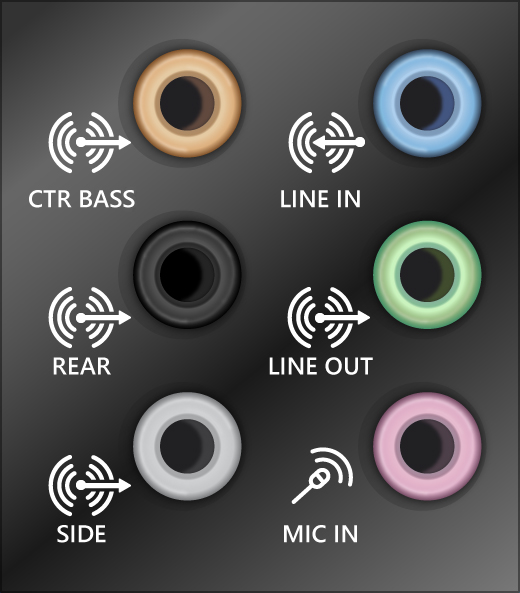
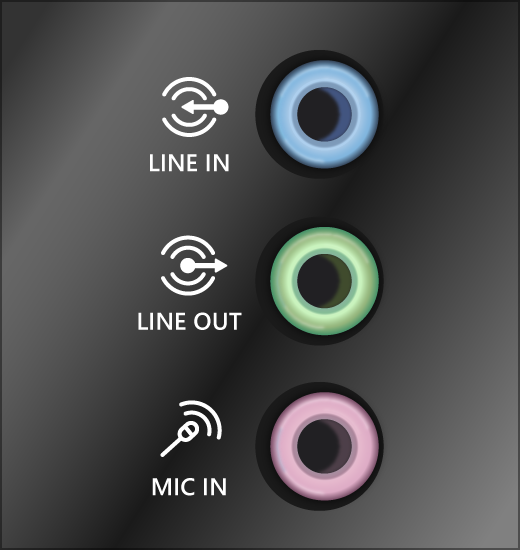
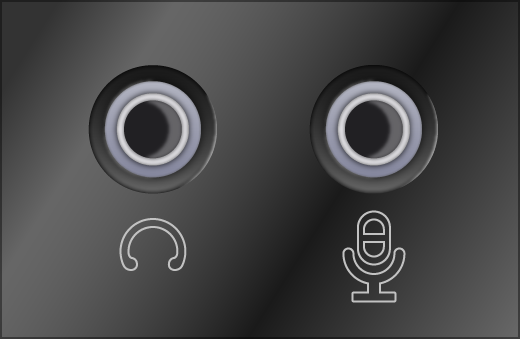
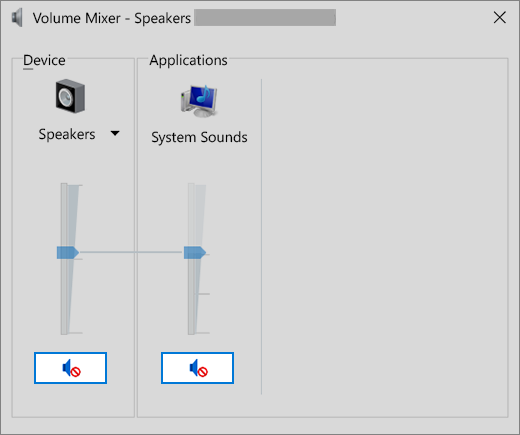
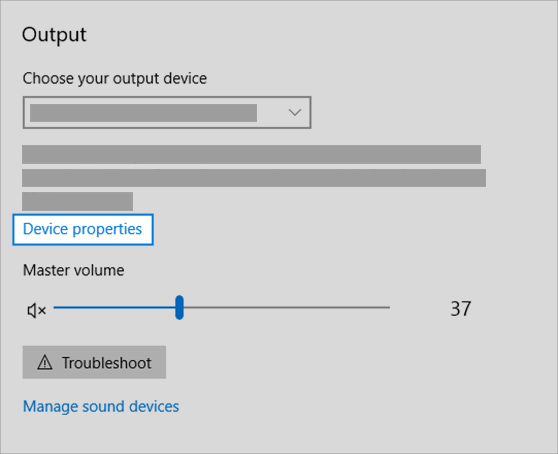
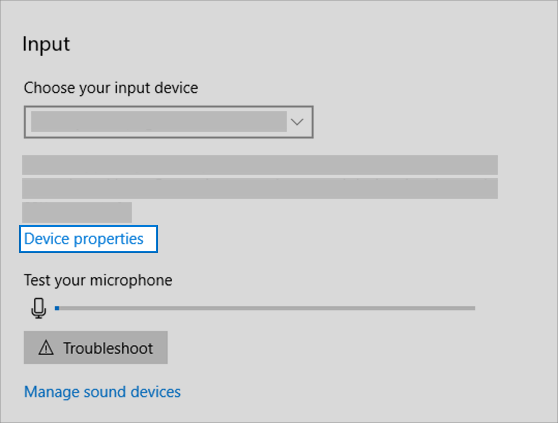
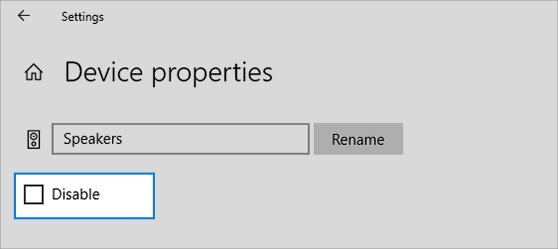
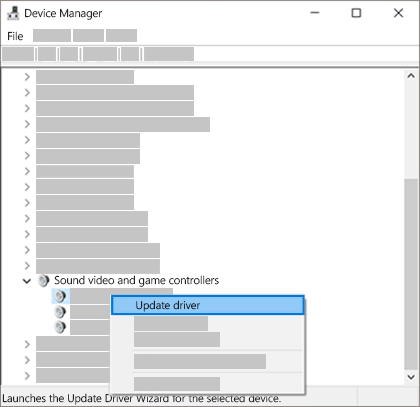
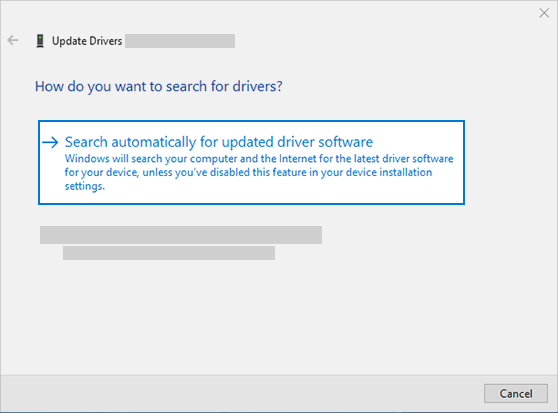
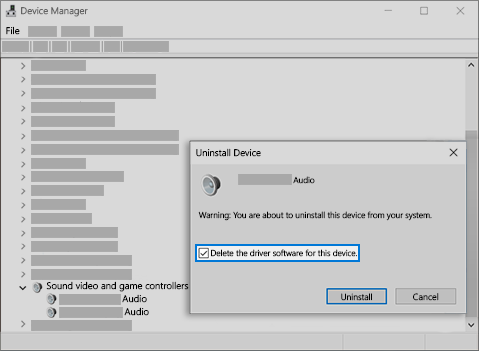
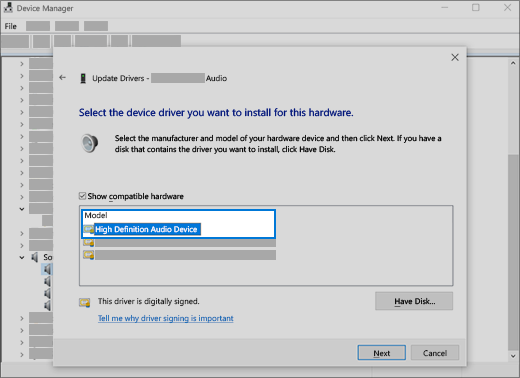


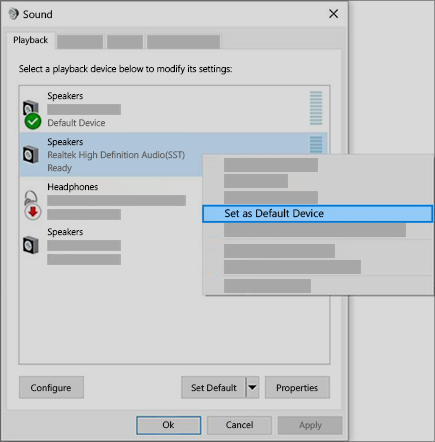
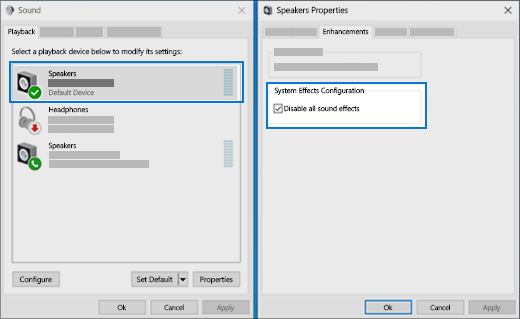
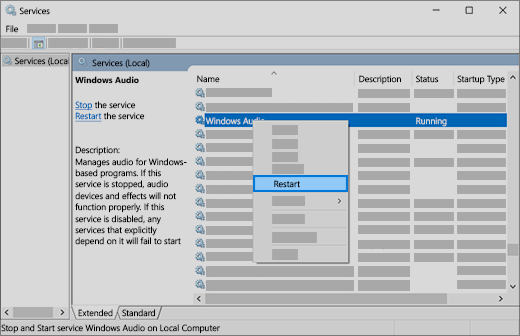
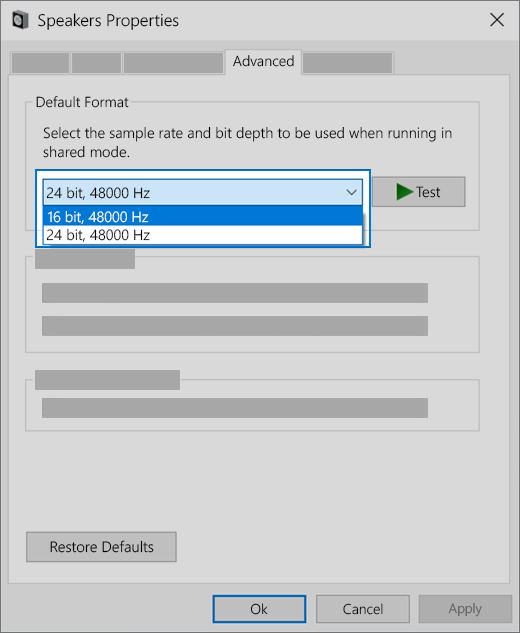
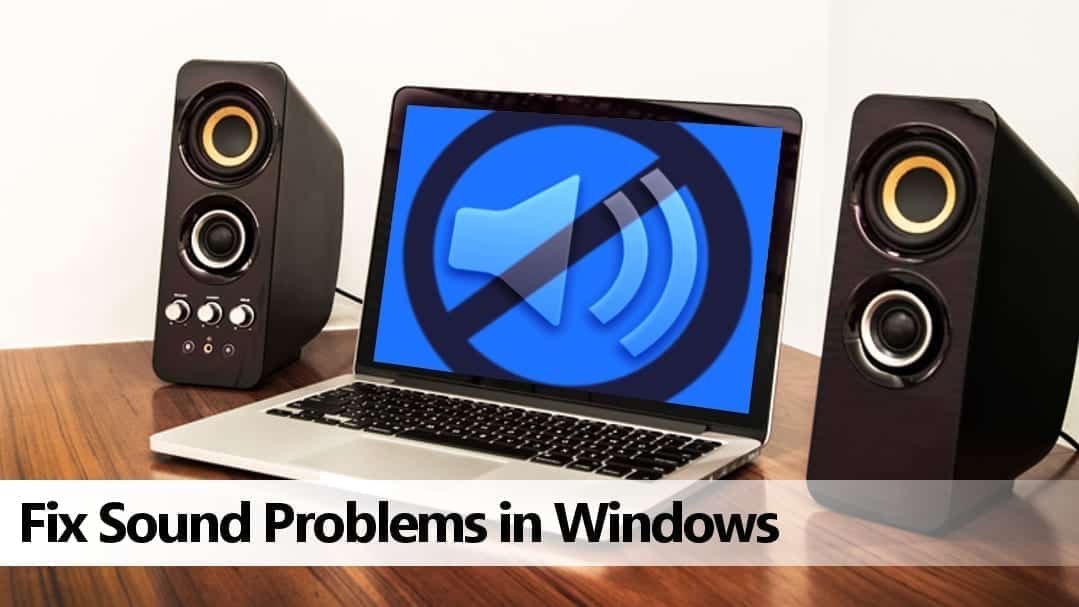 No sound in Windows 10 is a typical error
No sound in Windows 10 is a typical error